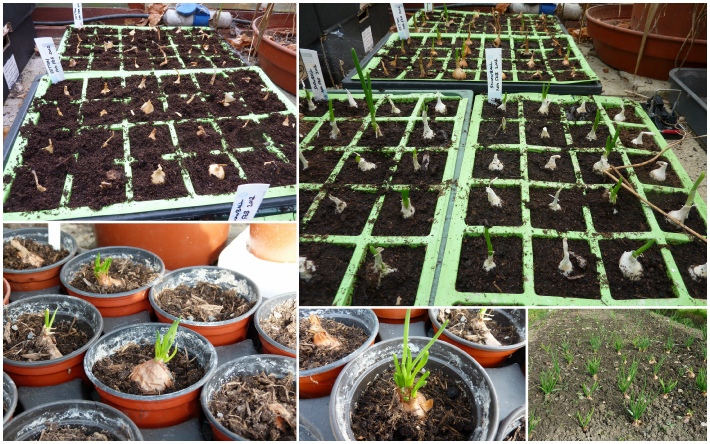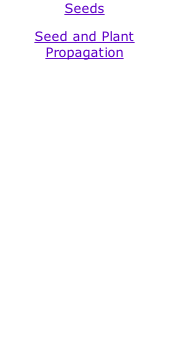




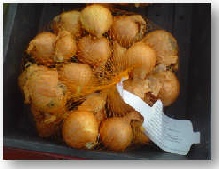
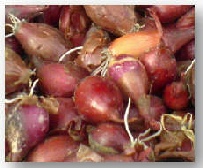
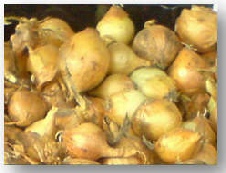
We use sets from which to grow our onions and shallots. Onions can be raised from seed but are more prone to problems and do not do as well on clay soil. The process also takes longer to produce a mature onion. Growing shallots from seed is fairly uncommon.
We usually plant heat treated onion sets. These are treated to cut down the chance of the plant bolting and producing a flower stem. The sets are kept between 25-26°C and 85-95% humidity for up to 3 months which destroys the flower bud in the centre of the set.The heat treated sets are more expensive but do perform better than those that were not treated so we think they are worth the extra expense. Heat treated sets are planted slightly later than other sets i.e. late March to Early April. Not all varieties of onions are able to withstand the heat treatment process.
Onion sets are smaller than shallot sets. An onion set is an immature onion which was grown from a seed the previous year. It will grow and form one onion, whereas a shallot set splits and forms a cluster of several shallots.
We also planted both onion and shallot sets last year to overwinter which will give us an earlier crop. The ones planted this spring will be good for storing over next winter.
Before planting the sets ensure that the soil is as free from lumps as possible and rake to level. The soil shouldn’t be hard packed. We then sprinkled the ground with fish, blood and bone fertiliser which was lightly worked into the soil.
Interesting fact or not!
Apparently each leaf of an onion plant produces one ring of the onion bulb!
Discard any sets that seem ‘empty’ and remove any loose skin. If the bulbs have very long skin tails you may wish to trim them but take care not to damage and sprouts that may have started to grow. Position the sets at the required distance apart.
Plant shallots about 15 cm (6”) apart and onions 10 – 15 cm (4”-6”) The closer together that you place the sets the smaller the resulting onions will be. A suitable sized board is useful as a spacing guide. Leave sufficient space to allow for weeding in between the rows.
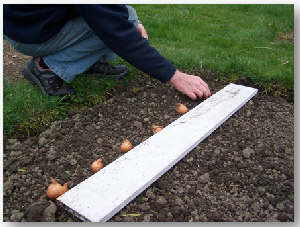
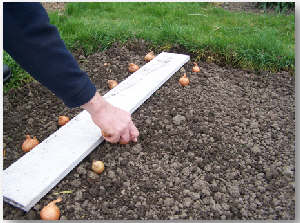
If the soil is very light and loose you may be able to push the sets into the soil but this can cause damage to the roots and can also produce a hard pack of soil beneath the set. The sets may also push themselves out of the soil. It is better to use a trowel to scrape a shallow hole in which to place the set, (pointed end up!), and then to carefully pull the soil back around the shoulder of the set.
Large sets should always be planted this way. Just leave the tip of the set showing. Birds will pull the sets out of the soil so if this is a problem it may be a good idea to cover with netting until the sets are well rooted. Replant any sets that are disturbed by birds.
The onion sets were planted in a slightly different way. First a very shallow narrow trench was scraped out using a trowel, the sets were placed in and then the soil scraped back around them leaving just the tips visible.

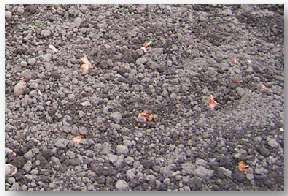
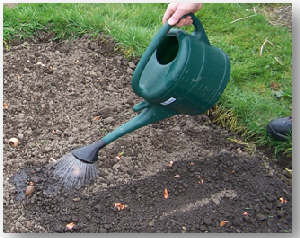
Once the sets have been planted water well. After that the sets will only need watering in warm, dry weather.
Flowering Onions:
An onion is a biennial plant. If the plant is subjected to alternating warm and cold spells the plant is fooled into thinking it has passed through more than one growing season and it may then start to produce a flower stalk.
The flower stalk will produce a hard inedible stem that runs through the centre of the onion. Once a flower stalk begins to develop there is nothing that you can do to stop the formation of this hard core so whether or not you break off the flower stem is to some degree irrelevant. The outer part of the onion bulb will still be useable but onions that have produced a flower stem will not store so should be used when pulled.
NB: The heat treated onion sets were a great success - only a couple produced a flower stalk and a bumper crop was produced of all three varieties, red, white and yellow - we'll be using them again!
Tip:
Weeding onion beds can be really awkward so leave sufficient space between the onion sets to allow you to hoe between them and also so that you can lean over and weed between the growing plants without bending the leaves. Weeds also seem to have an inbuilt survival tactic and root under the onion sets or so close to them that it is impossible to pull weeds out without uprooting the onions so try to pull out or hoe weeds before whilst they are very small. Failing that cut the weeds off so that the onions don't become swamped by weed foliage.


